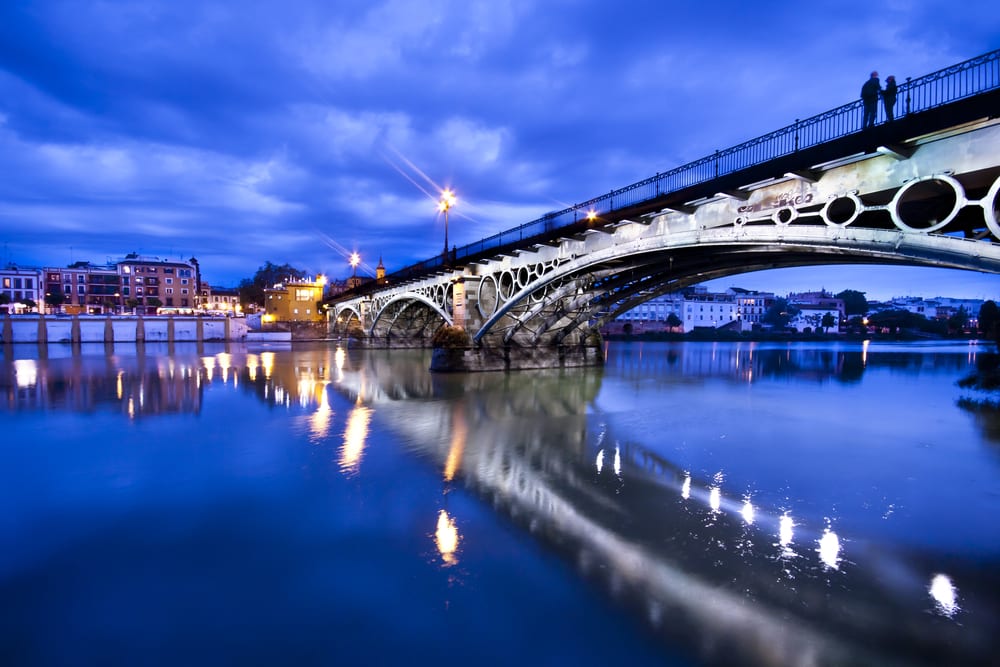Welcome to Triana, Seville
Welcome to Triana, Seville
Welcome to Triana, Seville
-
Hannah
-
Hannah

The closest city to the hacienda, El Pavon, where my characters live in Indiscretion is Seville, Spain. It is a city I know well, and love, and so I very much enjoyed describing my heroine, Alexandra’s, exploration of the place. As in my previous novels, where my heroines got to know Mombasa, Kenya, and Venice, Italy, I thought it important to show not only the pretty, admirable aspects of city life, but also the more colourful and darker side that lies beneath the veneer. In Seville, that meant taking Alexandra to Triana, home, in the 1950s, to a large Romani population – the gypsies.
In Indiscretion, there is a gypsy encampment on the de Falla land by the hacienda, and the story of the alluring gitana Marujita is interwoven with Alexandra and Salvador’s story. With gypsy culture and values featuring so prominently in the book, I wanted to take Alexandra to where I went as a young woman in Seville to learn about all of its people: the Triana bridge. In the book, Salvador is helping Alexandra to get to know her homeland, and to conduct research for her new romantic novel. So at sunset he takes her to Triana, which he sees as typical of Andalucia, and when Alexandra asks, ‘What’s so special about Triana?’, he replies:
‘Triana is the haunt of gypsies, the home of popular song and folklore dancing. In the days of Haroun El Rashid, it was the scene of magical Zambra festivals where they danced the ‘Dance of the Moors’, and since then Seville has become famous for musical culture throughout the western world, and Triana the heartland of flamenco. There is no place on earth I can think of where you can see so many bizarre and exotic characters. They are a different people, the Trianeros, with their unique traditions and a charm and wit all their own,’ he added, his face alight. ‘They have inspired the great musicians of the world. Rossini’s bumptious barber, Bizet’s bewitching Carmen, and Mozart’s frivolous Don Juan, all these characters are here.’
Triana sits on the west bank of the Guadalquivir River, almost an island in the water. Once, it was cut off as an arrabal–separated from the main city. The trianeros have a strong collective identity, and as Salvador suggests, a very vibrant culture. Originally, it was populated by sailors, potters and artisans, and it soon became a hub for toreadors and flamenco singers and dancers – and then, gypsies. They often lived communally in corrales: buildings with rooms opening onto central, shared courtyards with fountains. Few remain today, due to a programme to displace the gypsies in the 1970s, but their influence on local culture remains.
To reach Triana, you cross the 19th-century Isabel II bridge (Puente de Triana). This is Alexandra’s impression of that bridge:
As they approached the bridge, the chorus of voices became almost deafening, some shrill, others boisterous, punctuated by the shaky rattling of carts, the tintinnabulation of tram bells, the flat, repeated cries of street vendors. And over in the distance, on Seville’s waterfront, the dismal shadow of the Golden Tower, the old prison watchtower of the Guadalquivir, rose like some baleful omen of misfortune, casting its fiery reflection on the shimmering surface of the river in the light of the setting sun.
Once in Triana, passing the beautiful Moorish Revival Chapel of El Carmen, you may enter the market and look at the foundations of the Castillo de San Jorge, once the heart of the Spanish Inquisition; cross Altozano Square and admire the monuments to flamenco and to bullfighter Juan Belmonte; visit the Centro Ceramica Santa Ana (museum of pottery); and stroll along the waterfront street Calle Betis, lined with restaurants and bars that offer amazing views of Seville. Perhaps over a glass of wine or an iced orange juice, you’ll discuss with your companion the legend of Triana. Allow Salvador to explain:
‘Some people say that the goddess Astarte, amorously pursued by Hercules, took refuge at the bank of the Guadalquivir river. … Astarte was semitic goddess of fertility. The Greeks knew her as Aphrodite. She was so taken by the beauty of the riverbank that she thought it an ideal place to build a city. Hence the creation of Triana. Astarte’s dual influence of sexuality and war certainly seeps through the place…’
If you are in Seville then Triana is well worth a visit. But I hope, unlike my heroine Alexandra, you manage to explore the neighbourhood. For Alexandra does not even make it across the bridge; she is accosted by Paquita, an old gypsy woman, who is determined to tell her a foreboding fortune.
Careful, my beauty,’ she rasped as she drew closer to Alexandra, waving a withered finger at her, ‘do not delude yourself, do not be deceived, the devil is cunning!’